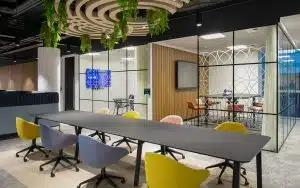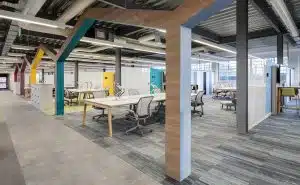Business leaders and HR teams are increasingly putting focus on, and resource into, enhancing company culture to help improve employee satisfaction, retention and recruitment, among other factors. In fact, a Gartner survey identified organisational culture as being a top-two priority for HR leaders in 2024.
So, what is culture in the workplace? Company culture usually refers to the shared values, beliefs and behaviours that characterise an organisation, and shape its personality and identity. It influences how employees perceive their work and how they feel towards the organisation. While companies do their best to define, shape and reinforce their culture, it also changes and evolves overtime as the business grows and changes.
Culture is usually shaped by a number of different factors, including:
- The company’s vision and mission
- Leadership style and organisational structure
- Policies and procedures
- Perks, benefits and rewards
- Core values
It can also be influenced by office design, and this is increasingly becoming a focus for forward-thinking businesses looking to create and reinforce a positive and inclusive company culture.
What are the benefits of a positive culture in the workplace
Improving work culture is likely to result in:
- Better engagement – employees who feel valued and happy are more likely to commit to their work and strive to achieve team or company goals. Research shows that employees with a positive experience of company culture are 16 times more engaged than employees with a negative experience.
- Boosted morale – a positive culture helps employees feel connected to their colleagues and evokes a sense of belonging.
- Positive reputation – companies with a positive culture are likely to have a better internal and external brand reputation, making it easier to win new business and attract and retain employees.
- Easier recruitment – people are attracted to organisations that are known for their positive team culture, workplace environment and policies. Reflecting your company culture in your core values also serves as a powerful recruitment tool, especially for younger employees. A recent LinkedIn survey backs this up, finding that 87% of Gen Z professionals would be prepared to quit their jobs and work elsewhere if they found a new company whose values aligned more closely with their own.
- Retaining talent – businesses with a positive company culture tend to experience lower staff turnover rates because satisfied employees who feel appreciated are more likely to stay with a company long term.
- Productivity – happy employees are more likely to be efficient and focus on their work, leading to higher output and performance.
- Collaboration and teamwork – in a culture of trust and mutual respect, employees are more likely to work together to share ideas, overcome challenges and achieve goals.
- A healthier work environment – a positive culture, supported by effective workplace design, can provide both mental and physical health benefits to employees. This includes reducing the likelihood of employees experiencing stress, aches and pains, and other negative outcomes commonly associated with sedentary and high-pressure office work.
Office design features to enhance company culture
When companies are looking into how to improve work culture, modern workplace design should play a leading role. Good workplace design can reflect and reinforce a company’s unique cultures, values, and aspirations, and can significantly impact how employees and visitors perceive the company.
Office design features that enhance workplace experience include:
Choice
Flexible workplace design, which gives employees choice and autonomy in where and how they work, helps instil a culture of trust and respect while increasing productivity and collaboration.
When designing workplace settings, companies should consider:
- Flexible workstations – ergonomic and adaptable furniture allows employees to customise their workspaces based on their preferences and tasks. Putting them in control of their personal settings, down to temperature and lighting choices, if possible, promotes comfort and autonomy.
- Collaboration areas – comfortable seating areas and interactive technology can facilitate planned and chance encounter brainstorming sessions among employees, fostering a culture of teamwork and innovation.
- Quiet zones – designated quiet areas or individual pods allow employees to focus without distractions, supporting individual productivity.
- Socialising areas and communal dining – shared lounges, dining areas and games rooms create more relaxed settings where employees can spend time together. This provides opportunities for fun and socialising while at work, encouraging interaction between departments and strengthening team relationships.
- Wellness or relaxation rooms – incorporating space for the team to pause and refresh, reflect, and meditate demonstrates a commitment to employee wellbeing, mindfulness and health.
Open plan office design
Light, bright and transparent layouts with glass walls, doors and panelling can encourage openness, communication and collaboration, creating a more inclusive and participative culture.
However, it depends on the workplace experience you want to create. If your organisation is wanting to reinforce a culture of autonomy and independence, separate and more structured working environments, with individual desks, dividers and private offices, might be more suitable.
Branding and values
Incorporating logos, mission statements and values into workplace interior design by cleverly using colour, branding and art, can help foster alignment with the company’s purpose, reinforcing culture and identity.
Technology
Modern office design typically integrates digital displays and interactive screens to facilitate communication, collaboration and teamwork.
You might also consider additional technology in the work environment, such as TVs in social areas, digital displays showing key metrics on sales floors, or music in office spaces to create a relaxing and happy atmosphere.
Inclusivity and diversity
Inclusive workplace design considers the diverse needs and preferences of employees, and ensures the office is comfortable, suitable, welcoming and respectful for everyone. Making adjustments for those with disabilities, for example, or introducing facilities such as prayer rooms, demonstrates a conscious commitment to diversity, equity and inclusion.
Wellness and sustainability
Incorporating elements of biophilic design in the workplace, such as natural light, greenery, and water features, promotes employee wellbeing and productivity, while also demonstrating a commitment to environmental responsibility and sustainability.
Next steps
The benefits of workplace design extend beyond offering your team choice, or improving productivity. Whether you aim to refresh your office environment to help create a more positive work culture, or to influence a culture change in the workplace, a carefully considered workplace design strategy is a crucial foundation to success.
To learn more, or to discuss your requirements with our experienced workplace design consultancy team, get in touch.




